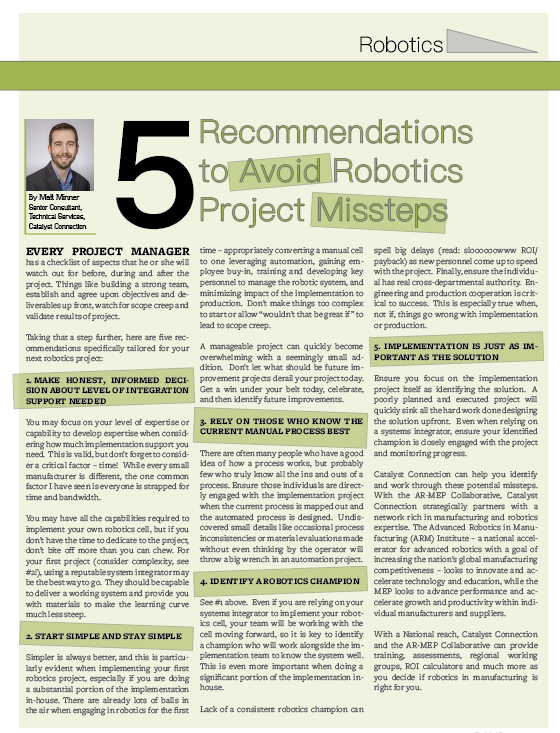Avoid Robotics Projects Missteps
By Matt Minner Senior Consultant, Technical Services, Catalyst Connection
 Every project manager has a checklist of aspects that he or she will watch out for before, during and after the project. Things like building a strong team, establish and agree upon objectives and deliverables up front, watch for scope creep and validate results of project.
Every project manager has a checklist of aspects that he or she will watch out for before, during and after the project. Things like building a strong team, establish and agree upon objectives and deliverables up front, watch for scope creep and validate results of project.
Taking that a step further, here are five recommendations specifically tailored for your next robotics project:
1. Make honest, informed decision about level of integration support needed
You may focus on your level of expertise or capability to develop expertise when considering how much implementation support you need. This is valid, but don’t forget to consider a critical factor – time! While every small manufacturer is different, the one common factor I have seen is everyone is strapped for time and bandwidth.
You may have all the capabilities required to implement your own robotics cell, but if you don’t have the time to dedicate to the project, don’t bite off more than you can chew. For your first project (consider complexity, see #2!), using a reputable system integrator may be the best way to go. They should be capable to deliver a working system and provide you with materials to make the learning curve much less steep.
2. Start simple and stay simple
Simpler is always better, and this is particularly evident when implementing your first robotics project, especially if you are doing a substantial portion of the implementation in-house. There are already lots of balls in the air when engaging in robotics for the first time – appropriately converting a manual cell to one leveraging automation, gaining employee buy-in, training and developing key personnel to manage the robotic system, and minimizing impact of the implementation to production. Don’t make things too complex to start or allow “wouldn’t that be great if” to lead to scope creep.
A manageable project can quickly become overwhelming with a seemingly small addition. Don’t let what should be future improvement projects derail your project today. Get a win under your belt today, celebrate, and then identify future improvements.
3. Rely on those who know the current manual process best
There are often many people who have a good idea of how a process works, but probably few who truly know all the ins and outs of a process. Ensure those individuals are directly engaged with the implementation project when the current process is mapped out and the automated process is designed. Undiscovered small details like occasional process inconsistencies or material evaluations made without even thinking by the operator will throw a big wrench in an automation project.
4. Identify a robotics champion
See #1 above. Even if you are relying on your systems integrator to implement your robotics cell, your team will be working with the cell moving forward, so it is key to identify a champion who will work alongside the implementation team to know the system well. This is even more important when doing a significant portion of the implementation in-house.
Lack of a consistent robotics champion can spell big delays (read: sloooooowww ROI/payback) as new personnel come up to speed with the project. Finally, ensure the individual has real cross-departmental authority. Engineering and production cooperation is critical to success. This is especially true when, not if, things go wrong with implementation or production.
5. Implementation is just as important as the solution
Ensure you focus on the implementation project itself as identifying the solution. A poorly planned and executed project will quickly sink all the hard work done designing the solution upfront. Even when relying on a systems integrator, ensure your identified champion is closely engaged with the project and monitoring progress.
Catalyst Connection can help you identify and work through these potential missteps. With the AR-MEP Collaborative, Catalyst Connection strategically partners with a network rich in manufacturing and robotics expertise. The Advanced Robotics in Manufacturing (ARM) Institute – a national accelerator for advanced robotics with a goal of increasing the nation’s global manufacturing competitiveness – looks to innovate and accelerate technology and education, while the MEP looks to advance performance and accelerate growth and productivity within individual manufacturers and suppliers.
With a National reach, Catalyst Connection and the AR-MEP Collaborative can provide training, assessments, regional working groups, ROI calculators and much more as you decide if robotics in manufacturing is right for you.